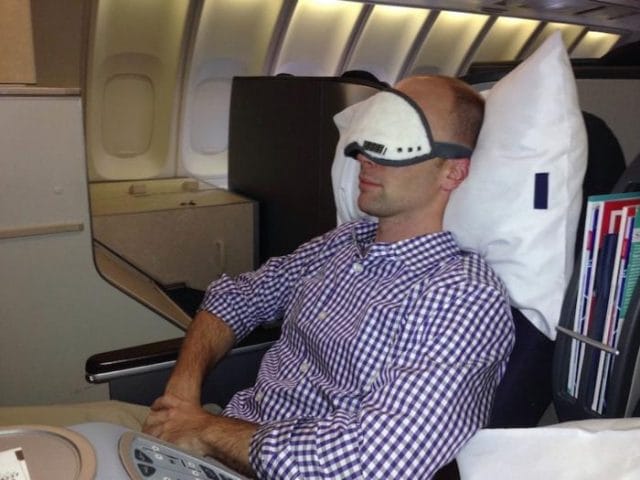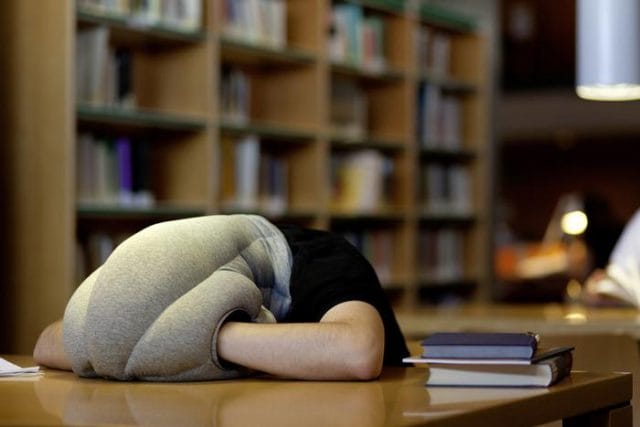
Editors note: This is a guest post by Nick Meyer, who is currently working on the Napwell, the world’s first Napping Mask. The Mask is currently running a Kickstarter campaign here.
Despite the proven benefits of napping, including enhanced job performance, reaction time, and memory retention, you probably do not regularly take a nap in the middle of your workday. If you are lucky enough to take a nap, sometimes you may even wake up feeling groggy and without getting the full mental-replenishment benefits of taking a nap. We don’t mean to criticize how you take naps, but perhaps there is some room for improvement?
So, let’s review some “hacks” that are aimed to optimize your napping.
Hack #1: Nap in the early afternoon, ideally right after lunch. Many cultures take advantage of this, from the commonly cited siesta cultures of the world to the power nap encouraged for employees of some traditional Japanese companies. That is because the body naturally reaches a lull in its circadian rhythm, and it is easier to fall asleep. This is a relatively well understood phenomenon, and has made it into mainstream sources outside of academic journals.
Timothy Monk, a professor of Psychiatry and sleep researcher summarizes the effects as follows in a paper titled the “The Post-Lunch Dip in Performance”:
Although it does not occur in all individuals and all measures, the notion of a post-lunch dip in performance is a real phenomenon that can occur even when the individual has had no lunch and is unaware of time of day. This phenomenon is related to an innate human propensity for sleep during the early afternoon hours. The post-lunch dip has its roots in our biology, and may be linked to the size of the 12-hour harmonic in our circadian rhythms. It is certainly exacerbated by a high-carbohydrate lunch, and may be more likely to occur in extreme morning-type individuals.
Hack #2: Nap where it is quiet and dark. This may seem like a no-brainer, but the brain more easily slips into sleep when it is dark and there is a lack of stimuli like noise and light. If you cannot get to a dark or quiet place to nap, then bring a sleep mask and a set of earplugs to nap.
The well understood mechanism for light’s effect on wakefulness is that it inhibits melatonin, an important hormone in regulating sleep . An article in the Harvard Magazine explains further:
Mangelsdorf professor of natural sciences J. Woodland Hastings has shown that even a split-second of light exposure can shift the circadian cycle of a single-celled organism by a full hour. Light interferes with sleep, at least partly because it inhibits melatonin secretion and thus resets the biological clock. For this reason, those seeking a sound sleep should probably keep their bedroom as dark as possible and by all means avoid midnight trips to brightly lit bathrooms or kitchens….
Hack #3: Nap for either 20 minutes or 70-90 minutes. This takes a bit more explaining, but there are basically two ways of napping to prevent yourself from waking up feeling groggy. This effect of grogginess after waking is called “sleep inertia.”
The first way to limit sleep inertia is to nap for only 20 minutes. As you sleep, the brain goes through four different stages of sleep, slowing down its activity more and more. During Stage 1 and 2, brain activity transitions from higher frequency alpha waves to slower theta waves as your brain signaling slows down. It becomes progressively harder and harder to wake the sleeper. To get the benefits of a quick nap without feeling too groggy, the sleeper should wake up after 20 minutes or so, before Stage 2 sleep continues for too long. This will lessen the sleep inertia, and allow the sleeper to continue with their day. See the representations below of the different brain wave activities, cited from Wikipedia’s great article on sleep.
Figure 1. Alpha Waves – present in the brain during wakeful relaxation, have a frequency of 7-12 Hz.

Figure 2. Theta Waves, present during Stage 2 sleep, have a slower frequency of 4-7 Hz.

The second way to nap is to allow enough time for the brain to slow all the way down to something called Slow Wave Sleep (SWS), or Stage 3 sleep, and allowing it to naturally cycle back to higher levels of activity before waking. It usually takes about 90 minutes to cycle through SWS and come back to a light sleep stage to wake up. If the napper awakens after a cycle of SWS, they gain many of the benefits of a full night’s sleep and can function at a higher level in the afternoon. If a napper wakes up suddenly during SWS, they experience sleep inertia, and often feel drowsy for up to an hour later.
Figure 3. Delta waves are associated with deep sleep (Stage 3, or Slow Wave Sleep) and have a frequency even slower, at 0-4 Hz.

As a side note, many people have heard of Rapid Eye Movement (REM) sleep, which is the fourth stage of sleep. REM sleep occurs as the brain is waking back up from a cycle through SWS, and is a lighter stage of sleep.
A great summary of this effect is given in an article by Tassi and Muzet in the journal Sleep Medicine Review:
One of the most critical factors is the sleep stage prior to awakening. Abrupt awakening during a slow wave sleep (SWS) episode produces more sleep inertia than awakening in stage 1 or 2, REM sleep being intermediate. Therefore, prior sleep deprivation usually enhances sleep inertia since it increases SWS.
Hack #4: Napping can mitigate tiredness, but is no replacement for a full night’s sleep. Even when following the guidelines above for smart napping, if you are exhausted from pulling two all-nighters in a row, your body will usually find a way to put itself to sleep. A sleep deprived person can fall into SWS within a few minutes of lying down, and will feel groggy when waking up before having “caught up” on their sleep debt—see the excerpt above on sleep inertia. Make sure you allow yourself enough time to fully recover if you have not slept enough, and plan your work or socializing appropriately. That said, it turns out that there are many benefits to napping even if you do get enough sleep at night.
Hack #5: Do not drink caffeine after your first couple of cups of coffee in the morning. Caffeine does stimulate the body, but it does not help support complex decision making and analytical thinking the same way that getting a full night’s sleep does. If you avoid drinking caffeinated beverages later in the morning, you should find it easier to take a quick rest after lunch.
An article by Mednick et al summarizes how caffeine can actually inhibit a person’s ability to recall explicit information (e.g. remembering someone’s phone number).
Overall, a daytime nap generally improved performance across three different learning paradigms, while caffeine impaired (or at least did not benefit) performance . . . This increase in hippocampal acetylcholine by caffeine may block the consolidation process by blocking replay of new memories. Consistent with this conceptualization, we found that the greater the explicit component of each task, the worse the caffeine group performed.
Conclusion
For many of you, you may be disappointed to learn you’ve been napping wrong this whole time. Do not despair, there is plenty of time for you too practice napping and improve. The above suggestions should help you minimize the grogginess you feel after a nap (sleep inertia), while letting you reap the mental benefits of taking a refreshing nap. Feel free to copiously experiment with snoozing until you find a napping system that works for you.
This is a guest post by Nick Meyer, who is currently working on the Napwell, the world’s first Napping Mask. The Mask is currently running a Kickstarter campaign here.




